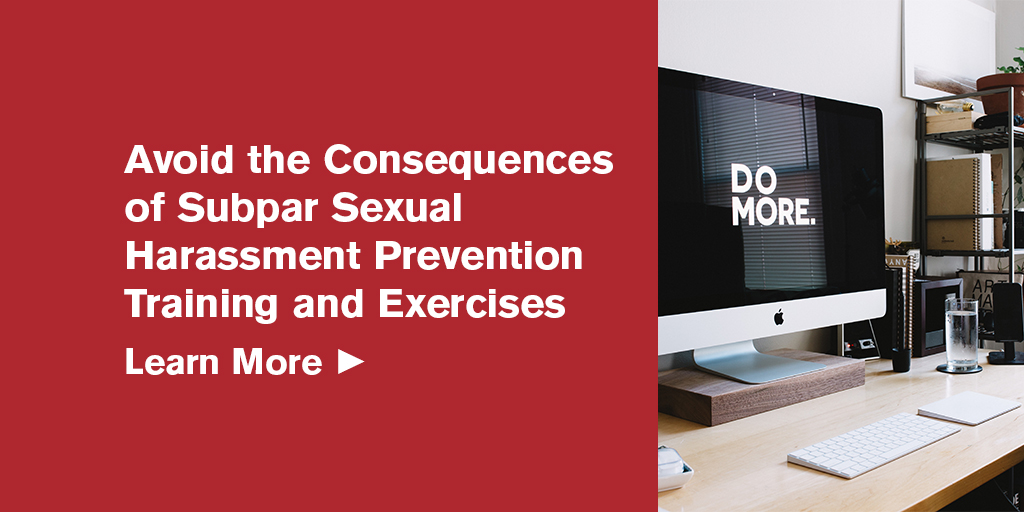By Jill Pappenheimer, Partner, Human Resources Consulting, BPM
This article originally appeared in the April 1, 2019 issue of the San Francisco Business Times and Silicon Valley Business Journal.
Talking about sexual harassment at work can be uncomfortable, but the consequences of ignoring it can be a lot worse.
The prevailing practice of avoiding sexual harassment prevention training where possible, or else only going about it in the minimal possible way required by law, has coincided with a culture in which illegal, inappropriate behavior is rampant and usually goes unpunished. That’s why activists and sympathetic lawmakers across the country are advocating for more employees to undergo sexual harassment awareness trainings, and to make these exercises more frequent and thorough.
California State Bill 1343, which lays out new workplace sexual harassment prevention training requirements for companies headquartered in the state, is a manifestation of that advocacy. Passed last year, the bill lowered the minimum number of employees required for a company to provide sexual harassment prevention training from 50 to five. Moreover, it extended the participant requirements from just employees in supervisory roles to all employees.
It’s a major victory, to be sure. In particular, because the bill requires employees to undergo sexual harassment awareness training once every two years, demonstrating an understanding of the basic psychological principle that knowledge that is not regularly refreshed is almost certain to be forgotten. However, SB1343 is by no means an end-all, be-all solution to workplace harassment.
For one, the bill doesn’t require in-person trainings; online training is considered sufficient. For businesses that can’t or don’t want to produce their own e-learning courses, generic videos, produced by the Department of Fair Employment and Housing, are available. But as anyone who has sat through two hours of even well-produced online HR training knows, the experience usually ends up being less rewarding and enlightening and more just an annoyance you have to get through. That’s not the kind of mindset you want for employees to increase awareness and be educated about a serious subject like workplace harassment to have.
In fairness, the language of the law does require the training to be “interactive.” But if the definition of that is broad enough to encompass something like multiple choice quizzes, the results aren’t likely to be much better than your grade school substitute teacher putting on a video for the class.
Why companies need classroom training
In short, even with the more expansive requirements of SB1343, it is up to the business community to create better workplace cultures, engage employees with equal opportunity and, ultimately, end workplace sexual harassment. But if it’s not legally mandated, why should companies take on the extra responsibility? In the light of the #MeToo movement, the public is placing a far greater emphasis on companies’ values and actions regarding harassment.
Since the beginning of the movement, dozens of high-profile companies and business leaders have been brought down by news about sexual harassment misconduct, whether that’s the personal actions of those in power or failing to correct flawed workplace cultures. As awareness continues to mount, there will be consequences for businesses that fail to keep up with the higher standards increasingly expected of them.
Against this background, opting for the bare-minimum webinar is a false economy. It’s not just that the interactive classroom setting has been proven time and time again to lead to better knowledge retention, increased learning and more engaged positive experiences. It’s also because such a sensitive topic, one that involves the actual relationships between the employees being trained, the interactivity between participants during training can be the key to creating the heightened awareness, safety to speak out, and empathy and support among employees that defines a healthy workplace culture.
One obstacle to every employee receiving the classroom-based sexual harassment prevention training is many small or midsize companies may not have the bandwidth or money to run training internally. Outsourcing services have grown up for nearly every aspect of HR, and sexual harassment awareness training is no exception. With outsourced HR services, you can bring in subject matter experts — people who would normally command large salaries — for consulting projects, interim support and training. Alternative to holding a training at a company site, is to send an employee to a public training for increase breadth and exposure while engaging with people from other companies.
There’s little excuse today for employees to miss out on the training they deserve. As your business considers how to respond to California’s new sexual harassment prevention training requirements, don’t settle for the letter of the law. Jumpstart the in-person, interactive and ongoing conversations employees need to have with each other to live happy, healthy work lives.
It’s not just trainings. From developing effective management skills to aligning employees with company strategy to regulatory compliance, organizations need a robust HR function to succeed. With our outsourced HR, recruiting and consulting services, BPM can help get you there. Contact Jill Pappenheimer at [email protected] today to learn more about how we can help.
Jill Pappenheimer is a Partner in the HR Consulting Practice at BPM, one of the 50 largest public accounting and advisory firms in the country. She brings over 25 years of experience in HR, working for a variety of companies ranging from large financial institutions to small entrepreneurial teams.
 This article originally appeared in the April 1, 2019 issue of the
This article originally appeared in the April 1, 2019 issue of the 


